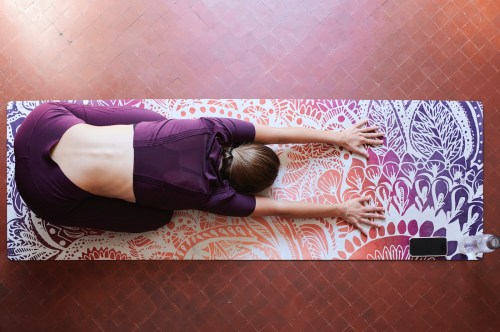The human body is home to 33 vertebrae that support your muscles, protect your spinal cord, and aid in other ways that help you, you know, have a spine. The thoracic spine, or middle back, sits just between your cervical and lumbar sections, and Loren Fishman, MD, medical director of Manhattan Physical Medicine and Rehabilitation in New York City, says it can be a painful area for some of us vertebrates. So to make sure your back feels good all the way from T1 to T12 (a little spine humor for you), Dr. Fishman gave us a handful of middle back stretches to commit to memory.
First, how common is middle back pain? And why do you have it?
“[Your middle back is] not a frequent source of back pain,” says Dr. Fishman. “There’s much more neck pain and much, much more lower back pain. The ribs act like outriggers and keep the spine in relatively good alignment, but you can get pains there especially if you’re doing a lot of lifting over your head, because those muscles have to contract.”
Rare as it is, though, discomfort in the center of the spine presents a very real—and very achey—problem for those who deal with it. “The main people [with middle back pain] are those who do the kind of exertion that raises your arms over your head—especially if they do so while they’re horizontal so that raising their arms in a way that conquers gravity,” says Dr. Fishman. Think: athletes like swimmers, weight lifters, and yogis—or anyone whose job requires heavy lifting day in and day out.
Dr. Fishman says middle back pain can also present itself when you find yourself newly in love… and probably having a lot of sex. “It’s not an infrequent thing to get after you start a new relationship,” he says. And thus, if you do find yourself getting it on atop a rougher, less back-friendly surface, consider grabbing a pillow (or a sex pillow) for your thoracic—would you?
A yoga therapist as well as an MD, Dr. Fishman recommends stretching three specific muscles to counteract the aches and pains that pop up as a side-effect of your favorite ways to move. “Most back pain in the thoracic spine involve the paraspinal muscles, the intercostal muscles between the ribs, and what’s called the serratus posterior inferior: another muscle that’s a triangle shape,” explains the doc.
Of course, you should always consult your own physician or specialist if you’re experiencing any kind of pain. But if they give you the go-to to stretch it out, we’ve got the middle back stretches your T1 through T12 will love.
5 middle back stretches, straight from a doctor-slash-yoga therapist
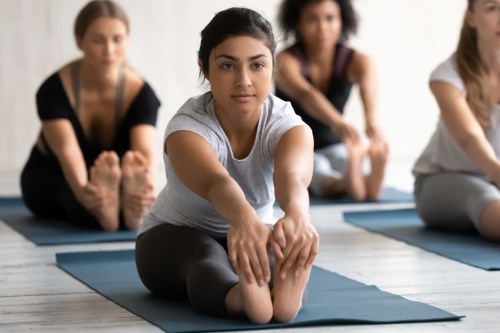
1. Seated forward bend (Paschimottanasana)
Step 1: Start seated on the floor with your legs extended in front of you and parallel. Flex your feet and hold your back tall.
Step 2: Hinge at the hips with a flat back, and lower your upper body over your lower body. Feel free to bend your knees deeply if it will help you touch your thighs to your chest.
Step 3: If it’s available to you, grab onto the outside of each foot with your hand. Release your neck and let your head hang heavy.
Stay for 5 to 10 breaths.
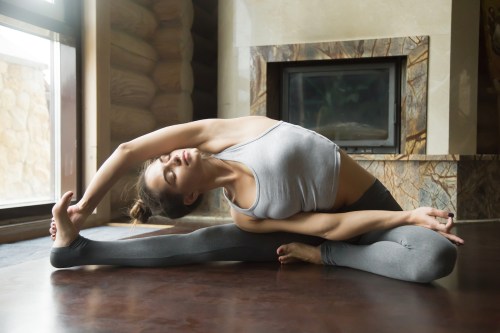
2. Revolved head to knee pose (Parivrtta Janu Sirsasana)
Step 1: Extend both legs out in front of you one more.
Step 2: Bend the right knee and place the sole of your foot on the inside of your left thigh.
Step 3: Rotate your torso to the right side of the room and reach your right arm over your head.
Step: Bend over to the left, feeling the stretch along your right side. If you can, touch your right fingers to your left toes.
Stay for 5 to 10 breaths and repeat on the opposite side.
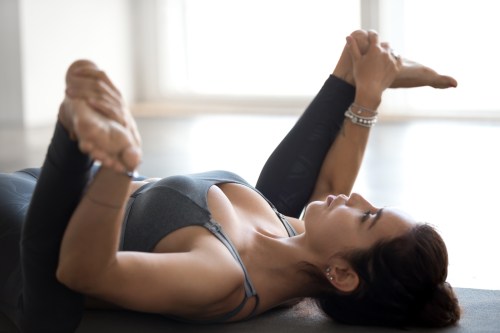
3. Happy baby pose (Ananda Balasana)
Step 1: Lie back and bend your knees into your chest.
Step 2: Grab the back of your thighs with your hands. Or, if you’re a bit more flexible, grab your big toes with your fingers or wrap each hand around the outer foot.
Stay for 5 to 10 breaths.
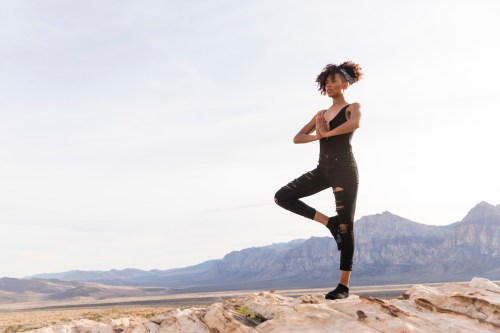
4. Tree pose (Vriksasana)
Step 1: Stand at the front of your mat with your feet together.
Step 2: Place the inner sole of your right foot on the inside of your left thigh, calf, or ankle. (Avoiding the knee.)
Step 3: Bring your hands to a prayer position at the chest. Then, lift your prayer hands up and over your head to stretch out your middle back.
Stay for 5 to 10 breaths and repeat on the opposite side.

5. Revolved Triangle Pose (Parivrtta Trikonasana)
Step 1: Start standing at the top of your mat.
Step 2: Step your left foot about three feet out and turn it so that it’s pointing to 10 o’clock. Make sure your feet are hip-width distance apart.
Step 3: Face forward and hinge at the hips, bringing your left foot either inside or outside your right foot (a block can be helpful here).
Step 4: Place your right hand on your low back and twist. If accessible, you can extend your right arm to the sky instead.
Stay for 5 to 10 breaths and repeat on the opposite side, pointing your right toes to 2 o’clock this time.
Work on your overall flexibility with this sequence:
Learn how to strengthen your low back to have good posture #forlife. And if you’re dealing with a fair bit of pelvic tilt in yoga, here’s what to do.
Sign Up for Our Daily Newsletter
Get all the latest in wellness, trends, food, fitness, beauty, and more delivered right to your inbox.
Got it, you've been added to our email list.
